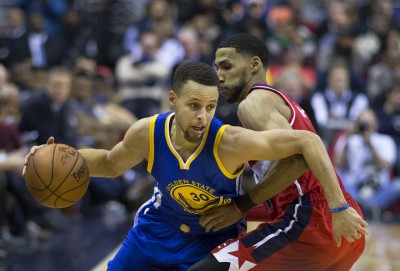
72-9. How sweet it sounds.
The Golden State Warriors will have the chance to break the NBA record for wins in a season Wednesday when they take on the Memphis Grizzlies at the vaunted Oracle Arena in San Francisco.
Regardless of your allegiances or biases, this feat, if achieved, would be nearly unprecedented among the United States’ major professional sports leagues. The Warriors have redefined and reshaped the very nature of basketball over the course of the 2015-16 season. Understandably, this “basketball nirvana” of sorts has garnered tons of media attention. It’s been steady and unrelenting, primarily because the Warriors got off to the hottest start in NBA history (24-0) and haven’t looked back.
For those on the outside looking in, this type of coverage emphasizes one major theme: disparity in the NBA. This stereotype has plagued the league for well over two decades. It’s hard to fault its propagators — more than any other major professional league, the NBA is carried by its great teams. For the past two years, this has been the Warriors. Before that, it was LeBron James’ Miami Heat, and in the mid-2000s, it was storied franchises like the Los Angeles Lakers and the Boston Celtics.
The nature of disparity necessitates a profound gap between the top and the bottom, and for those seeking cannon fodder in their crusade against the NBA, they need only look to the Philadelphia 76ers. Over the past three years, the woeful franchise has accumulated just 47 wins, a figure nine teams have reached this season alone.
Each year, the NBA sees several franchises employ the “tanking” strategy popularized by the 76ers. The theory is simple: If your team is already bad, lose as much as possible so as to maximize your chances to gain talent through the draft. This concept is not new.
Both the NBA and the NHL use a lottery system to dissuade franchises from tanking, and both leagues still fall prey to it. The MLB has had bouts of tanking as of late, as franchises like the Philadelphia Phillies, Atlanta Braves and Colorado Rockies have all forgone their 2016 campaigns and will look to trade their marketable assets in hopes of future success. The NFL has hardly been immune to the phenomenon, either. The 2011 Indianapolis Colts went 2-14 en route to snagging one of the best quarterback prospects of all time — Andrew Luck.
Regardless of similarities across leagues, the NBA has gained a reputation as the most predictable. In part, this is due to the unpredictability found in its counterparts. The NHL boasts perhaps the best postseason in sports with the Stanley Cup Playoffs, the NFL sees yearly turnover in its division races and despite its 162-game schedule and the MLB’s 10-team playoff structure makes it extremely difficult to map out.
By contrast, most pundits agree that this year’s NBA Finals will once again play host to the Cleveland Cavaliers and the Warriors, just as they did in 2015. Ho hum.
However, this predictability is the product of an unpredictable league. Take, for example, the Warriors.
https://www.youtube.com/watch?v=MSp1ehqQZIs
In 2011-12, they finished 23-43 in a lockout-shortened season. Seeing potential in a young team, general manager Bob Myers capitalized on the unconventional. In March 2012, he dealt fan favorite and longtime scorer Monta Ellis to the Milwaukee Bucks for rim-protecting center Andrew Bogut. Eight months later, he signed a skinny guard with faulty ankles to a contract extension. The recipient was Stephen Curry, who has since put together the two finest shooting seasons in NBA history.
Following a 51-31 record and a playoff berth in 2013-14, Myers shook things up once again. This time he fired head coach Mark Jackson, replacing him with longtime television analyst and front office man, Steve Kerr.
Kerr wanted to install the pace-and-space system made famous by Mike D’Antoni’s mid-2000s Phoenix Suns, but he was missing a vital piece to the puzzle. Fortunately for him, the puzzle piece revealed himself when power forward David Lee went down with a hamstring injury before the 2014-15 season.
Draymond Green was an unheralded, position-less second-round draft pick in 2012. When Kerr called on him to take Lee’s spot in the rotation to start 2014, he had no idea what to expect. What he got was a versatile rock on defense and screen-and-roll wizard on offense. Green unlocked countless sets for the Warriors on both ends of the court and, alongside Curry, helped them to a 67-15 record and the franchise’s first championship since 1975.
Ultimately, how did a middling NBA franchise produce one of the best teams of all time? Luck and calculated risk. And that’s where parity comes into play in the NBA: the middle.
https://www.youtube.com/watch?v=WGZyFDWrU4g
Unlike its competitors, the NBA manufactures parity structurally. A single acquisition can change the entire dynamic of the league (see LeBron James). Its cap structure lends itself to wild variations across the league landscape, which makes each transaction potentially franchise-altering.
Teams like the Utah Jazz, Portland Trail Blazers and Detroit Pistons are all prime candidates for Warriors-esque ascension with young rosters chock-full of skills and seasoned head coaches capable of developing raw talent. Or maybe the new sensation will be the 28-win Minnesota Timberwolves led by rising superstars Karl-Anthony Towns and Andrew Wiggins. Add in a free agent here and a draft pick there, and who knows what can happen.
The NBA won’t produce Cinderella moments in the standings. Those happen at the negotiating table. Outwardly, the league will always appear stagnant, fiercely loyal to its stars, but internally, it’s ever changing, sometimes years ahead of the on-court product. The Warriors hold the throne right now, but you can be sure a new threat waits in the wings.
73-9? Stay tuned.



















































































































